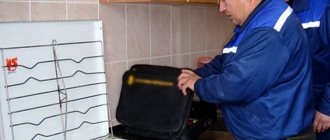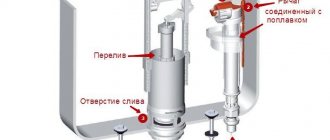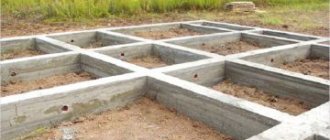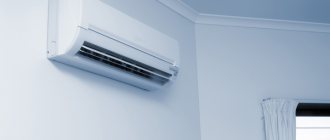In the construction of panel and brick houses of previous times, facade insulation was not provided.
Meanwhile, brick and concrete have rather low thermal insulation properties and high density. This leaves the walls cold and can result in an uncomfortable temperature.
Cold walls are the main sources of heat loss. They are trying to cover them with carpets and stuff them with furniture, but this is not a solution to the problem.
So, if you have a cold wall in your apartment, what should you do? Why this happens, where to go and how to insulate it yourself - this will be discussed further.
Reasons for the appearance of cold walls
Cold walls can appear in both old houses and new buildings. The most common causes of this unpleasant everyday phenomenon include the following:
- thin external walls;
- north side in the corner room;
- presence of defects due to the fault of the developer;
- the outer end wall has a lot of free space;
- the seams between the panels are made with irregularities or are destroyed during operation;
- lack of heat in the room - the radiators heat poorly, which is why the humidity turns into mold on the walls;
- poor ventilation performance - excess moisture is removed due to the good performance of the ventilation ducts;
- crack formation;
- getting the wall wet.
The reasons may be different, and their nature can only be determined by a qualified specialist with practical experience in the field of construction or housing and communal services.
Easily solvable causes of cold in a new building
If it is cold in a new building, this does not mean that the house was built using low-quality materials and non-compliance with construction technologies. Remember what time of year the house was put into operation. If this happened in the winter or spring months, it is quite possible that it simply did not have time to warm up during the first heating season. Firstly, the walls of the building must completely dry out and warm up properly. Secondly, a newly built apartment building is not yet habitable. Neighboring apartments may still be empty, and the heating in them may not be turned on, which will also affect the heat level in your apartment.
Heating in a new building, if it is properly and efficiently equipped, should work well. However, if the house is rented out during the cold season, then during the first heating season the apartments can be quite cool.
In principle, this is a normal phenomenon for many modern new buildings. All you have to do is wait until the next heating season and then draw conclusions about the operation of the building’s heating system.
How to insulate a cold wall
If the management company or homeowners association delays repairs or refuses to do them, you can take some measures yourself. If there is a need for this, you can use the services of specialists in this field of repair.
In order not to risk your own health, not to change the interior and not to pay for heating the street, you need to insulate cold walls.
There are several ways to insulate a wall in an apartment so that it is not cold:
- Insulate with mineral wool or expanded polystyrene - these are the materials most suitable for insulating insulation. They are covered with plasterboard, primed and painted, preferably in the color of the house, so as not to stand out against the general background. But there is no need to use these materials inside a panel house. They, of course, will become warm, but will condense all the time due to the accumulation of warm vapors between the insulation and the outer wall. Mold and mildew may even appear. The insulation must have a low level of heat conductivity, a minimum rate of water absorption, sound insulation properties, strength and durability.
- Additional heating in the form of an infrared film device can be mounted on the wall. However, serious renovation and finishing will be required.
- Installing a warm baseboard on the wall - this heating method affects not only the wall, but the entire room. The plinth is installed along the outer wall, runs on water and electricity, is safe for health, and also prevents the appearance of mold and mildew.
- Additional placement of heaters is a wasteful way, since the electricity bills will be rather large.
How should an inspection report be drawn up?
An emergency service employee takes measurements in the largest room of the apartment, at a distance of 0.5 m from the heating radiator. After this, he draws up a report that shows whether there are any violations and whether the heating service is provided correctly. If you agree with the verification, then you need to sign the document. If a dispute arises, a re-inspection is scheduled.
Contact lenses developed to correct color blindness
WHO: the situation with coronavirus in Russia is improving for the second week
The 14th Dalai Lama was vaccinated against Covid-19 in his Indian city
Subsequent actions depend on the causes of the cold in the apartment:
- If the temperature drop was caused by actions that do not depend on the performer, then you will have to solve the problem yourself. For example, when the rooms are cold due to open windows and doors.
- If a specialist determines that not enough thermal energy is supplied to the radiator, then the problem must be solved by the company servicing the house.
Prevention of wall freezing
To prevent the wall from freezing in the future, you must do the following:
- insulate and glaze the balcony if the problem wall is located nearby;
- check and repair, if necessary, the ventilation system;
- patch cracks and defects with silicone sealant.
All these recommendations taken together are the answer to the question of what to do if the wallpaper peels off on a cold wall. This is due to increased dampness that needs to be dealt with.
Heat transfer from object to object
When 2 objects with different temperatures come into contact, heat will be transferred to the object with a lower temperature, which will gradually heat up, and the warmer object will cool down, giving up some of its heat.
How different heat leaks occur in the house:
- the walls give off heat to the foundation, and the foundation to the ground;
- walls, entrance doors and windows give off heat to the outside;
- ceilings give off some of the heat to the attic air;
- the roof gives off heat to the air outside (if there is attic heating);
- heat from the floor in the house is transferred to the air under the floor, the foundation and the soil.
The house loses most of its heat in such direct ways.
To prevent such direct heat transfers, materials with poor thermal conductivity (insulation) are used.
What to do if the wall is frozen
You can understand this situation and take effective measures only after finding out the reason for the freezing of the wall. To do this, you need to contact the company responsible for maintaining your home. This could be a management company or a homeowners association.
A written application will need to be submitted . It will be reviewed within the framework of current legislation, after which a specialist will be sent to you to inspect the condition of the wall.
After the procedure, the owner will be given a corresponding certificate. This document is confirmation of an inspection to identify the cause of freezing.
You can immediately contact a company specializing in thermal imaging surveys . This is a paid type of service that allows you to get complete information about the problem.
A written opinion from a specialist from this company will allow you to contact directly the management of the management company or HOA and more quickly resolve the issue of correcting the deficiency.
Who is responsible for maintaining normal temperature
Organizations servicing the house must monitor compliance with the standards. This could be a management company, HOA, housing cooperative or other organization with which the cooperative has an agreement. Each such company has an emergency dispatch service, the telephone number of which will be useful for all residents of the house to know. As a rule, the necessary contacts can be found at the information stand on the 1st floor of the house.
Russia has begun developing a vaccine against bird flu H5N8
Marine Wildlife Center volunteer from Wales finds ball lost in Ireland
The baby's face immediately changes as soon as he sees his favorite presenter (video)
You can report a temperature problem either verbally or in writing. In the first case, you need to call the dispatch service, give the address of the house and your apartment. The employee must accept the application and inform you when the experts will be able to come.
If the dispatcher knows why the heating was turned off, he will inform you about the time frame for correcting the situation. If he does not have such data and does not know why problems appeared at this particular address, then he must schedule an inspection. The caller must be notified of the day and time when an emergency service representative will come to him.
Features of drawing up and filing a complaint
If the problem of a cold wall is not solved, then where to complain in this case? In private houses, the problem is solved by the owners themselves. In apartment buildings, management companies should deal with this issue.
If it is established that the culprit of freezing is the developer who built the house and made mistakes during construction, then the complaint will need to be addressed to him.
If a response does not come within 1-1.5 months or the developer refuses to correct the defect, you will have to contact higher authorities:
- local administration;
- the prosecutor's office;
- Maintenance of housing inspection;
- court.
According to current legislation, it is not prohibited to apply to several authorities at the same time . This rule is also valid in 2021.
How to write a complaint
The complaint must contain the text of the appeal, in which it is important to indicate the name of the organization to which you are applying. You must indicate your full name. applicant, that is, yours, residential address, feedback method (phone number).
The complaint must describe the essence of the problem, the reasons for its occurrence, and the need for elimination . The written application should be supported by evidence, for example, an inspection report from a third-party specialist.
Also, the claim must be dated and signed.
What should the temperature be?
Resolution of the Russian Federation No. 354 of May 6, 2011 presents all the main options for temperature conditions in residential and apartment buildings. According to this document, the temperature in the apartment must be at least +18 °C or +20 °C, depending on the region of residence of the person. For corner rooms, the minimum value is +20 °C or +22 °C.
If the indicators are lower, then this is considered unacceptable. In such a situation, measures must be taken.
Features of insulation in brick houses
At the beginning of work, you need to protect the surface and apply a primer with antifungal components. When insulating with mineral wool, a frame is built from slats, and pieces of material are placed between them on glue. Glue is applied to the wall, the seams are covered, and rubbed. Then gypsum board, primer, paint, and wallpaper are laid.
When working with polystyrene foam, the glue is applied with a spatula. There should be no gaps left; they are reliably coated with sealant. The finishing is carried out with a fiberglass plaster mesh - it helps to smooth out the adhesive layer, and the gypsum board is fixed to it.
In a brick house
When applying plaster, 3 layers will be required, each layer must be completely dry. Then a primer is applied, a leveling layer. The wall is painted or wallpapered. To insulate the corner, you can use thermal paint. Before applying it, prepare the base, then apply the paint with a roller or brush. After drying, you can glue the wallpaper.
External insulation
For external cladding, mineral wool, polyurethane foam or expanded polystyrene are used.
The mineral wool is placed on glue, additionally secured with anchors, the resulting seams are rubbed down and smoothed with sealants. Reinforcement is placed on top, then facade paint is applied.
Expanded polystyrene is placed on a profile frame. The walls underneath the material are treated with a special solution. The slabs are placed on glue. The corners are rubbed down, a layer of plaster and paint are applied on top.
When using polyurethane foam, a metal mesh is first installed. The material is applied by spray. It is covered with adhesive, reinforcement, plaster, and façade paint.
Waterproofing a country house
Effective moisture protection is also necessary for every home. It includes a membrane of roofing felt, waterproofing or bicroelast between the frame wall and the plinth. If the base is thick relative to the wall, it is necessary to drain it to remove moisture. To avoid dampening of the insulation in the walls, it is necessary to provide an air layer for it with a thickness of at least 50 centimeters.
Remember that wet insulation loses its properties and is destroyed.
To protect the insulation from blowing, windproof material is used on the surface of the insulation located on the side of the air gap. And also “vents” are made in the upper and lower sections of the walls so that the air gap is ventilated.
Heat leakage with infrared radiation
Infrared waves are emitted by any object whose temperature exceeds absolute zero. Moreover, the higher its temperature, the more infrared rays it emits.
Walls (if they are warm), ceiling, doors, etc. – all this releases radiant energy into space (and into the bargain, the owner’s money!)
The largest amount of such energy leaves the house through transparent glass windows. The metalized glass coating reflects most of the IR heat back into the house.
Experts have calculated that the use of such glass saves about 1 ton of solid fuel per season, especially in northern latitudes.
How does humidity affect the quality of thermal insulation?
Dry air has poor thermal conductivity. The more steam it contains, the higher its thermal conductivity. As the air humidity in the room increases, the heat transfer process goes faster.
Humid air inside the insulation reduces its thermal insulation characteristics. When the moist air inside the insulation turns into water (the insulation gets wet), it simply loses its ability to insulate.
Therefore, the main task during insulation is to prevent the insulation and enclosing structures from getting wet.
Coping with this task is not so easy, because with a sharp temperature change, a “dew point” appears, that is, the temperature at which steam condensation occurs.
For high-quality insulation, it is important to correctly observe the location of its layers. The outer layer must allow steam to pass through. And no less important is the creation of a system of ventilation ducts for insulation.
An apartment after renovation always shines with freshness and newness. I would like to prolong this state as long as possible. Floors or slopes can serve us for more than one year, but there are materials that are not durable. For example, it is difficult to deal with such phenomena as damage to wallpaper, and especially in the area near the bed. But probably. Let's look at some of the most effective ways to protect wallpaper from abrasion when the bed is against the wall.
Headboard stationary and hanging
The simplest option would be to buy a bed with a headboard. If you already have a bed, the headboard can be purchased separately: stores provide the opportunity to equip it with a suitable design.
If the bed is in a corner, choose a model with high sides. They come in different materials: hard, chipboard, or soft, upholstered in material or leather.
If a bed with a fixed headboard does not suit you for some reason (it is longer than standard furniture and may not fit in a small room), use hanging headboards. They will help make the bedroom much more comfortable. Awnings can be made to order or independently, the main thing is to adhere to the overall design of the bedroom.
How to make a canopy
Cut out the required headboard shape from plywood or chipboard. Place a layer of padding polyester or foam rubber on it and secure it with a construction stapler. Select a material that is suitable in color and texture (consider the color of wallpaper, furniture and textiles), secure it with staples. The material you can use is velor, tapestry or eco-leather - it all depends on your preferences. You can decorate the design with decorative buttons.
Instead of a monolithic block, soft decorative pillows are also suitable as a canopy. In many ways, they turn out to be an even more advantageous option. The pillow cover is easy to replace and wash when it gets dirty. You can make several design options for covers and change the appearance of the room to suit your mood.
Finally, the last stage. You need to sew loops to the wall-mounted headboard (or pillows) and hang it on a rod above the bed. You can decorate a homemade headboard with pockets and compartments, which will become additional storage space in the bedroom.
Long shelf
Using one or more shelves, you can also protect the wallpaper from abrasion near the bed. It is advisable to choose narrow, lightweight designs that do not visually burden the interior. On the contrary, due to the horizontal arrangement, they visually expand the walls in the bedroom. It is enough for small decorative elements to be placed on the shelf: vases, figurines, photographs. To insure against them falling, opt for a shelf with sides.
Pay attention to bed models that come with shelves. A convenient design solution will fit especially well in a child’s room or in a small apartment where the sleeping area is located in the living area.
Silkscreen printing
You can make the wall next to which the bed stands more contrasting. For example, if the wallpaper on all the walls in the bedroom is the same color, you can highlight the area above the bed with stripes or an ornament. Wallpaper with silk-screen printing is best suited for this. Silk-screen printing not only looks chic in the interior, these wallpapers are more durable and wear-resistant - their standard service life is 10–15 years. They are also easy to clean with a damp sponge.
The top layer of silk-screen wallpaper contains vinyl with silk threads. It can be embossed or smooth, and looks very similar to silk texture. Using silk-screen printing, it is easy to imitate the texture of leather, decorative plaster and other textures. However, the wall for gluing silk-screen printing must be perfectly flat, otherwise all the irregularities will appear.
Liquid wallpaper
If the bed is close to the wall, then keeping the wallpaper in pristine cleanliness is very difficult. They will inevitably get dirty and rubbed. Liquid wallpaper, which has a number of advantages, will be your salvation in this case:
- moisture resistant,
- resistant to fading and UV rays,
- hypoallergenic,
- can be applied even to uneven surfaces - they fill cracks and roughness,
- can be further decorated.
Liquid wallpaper is presented in a wide color palette and you can always choose the desired shade.
Panel
If you decide to use this method of decorating your bedroom and protecting your wallpaper, consider the size of the room and its level of light. The panel will fit perfectly if the following rules are observed:
- the right place for its placement is chosen,
- lighting accents are well placed,
- Apart from the panel, there are no other decorative elements on the wall.
If you use a mirror panel, place it so that it reflects the light as much as possible - this will expand the space and make it more airy. You can use photo or 3D wallpaper as a panel. Lately, LED panels have also become increasingly popular.
Carpet or tapestry
Until recently, carpets on walls were considered a relic of the past. They were not called anything other than “grandmother’s design” or “dust collector”. But it's unfair! The carpet perfectly protects the room from the cold, serves as an element of sound insulation and, of course, protects the wallpaper from contamination.
Recently, carpets have slowly begun to come back into fashion. For example, if the room is decorated in an oriental style, then you cannot do without a carpet on the wall. Symbols of home comfort and tranquility also look great in Moroccan, Scandinavian or vintage interiors.
When choosing a carpet, the main thing is to choose the right colors. Carpets in pastel colors will look good on light walls. On dark ones there are rich, colorful patterns, as well as carpets with neutral shades (beige, gray or white).
If you are still not ready to hang a carpet on the wall, you can opt for a tapestry. It looks not banal, but even elegant, and can become a beautiful decorative accent. Perfect for interior in ethnic style.
Wall panels
Wall panels made of PVC, MDF, chipboard or fiberboard are a very popular finishing material with a huge variety of colors and shapes. The panels perfectly protect walls from dirt and abrasion. In addition, they also have a number of advantages:
- easy to install,
- they can be installed on any walls - they hide all problems,
- durable,
- provide a wide field for the designer’s imagination,
- protect walls from the paws of pets,
- easy to care for.
They have only one drawback: during installation, the area of the room decreases. Therefore, the material is not suitable for small rooms. As an alternative for compact spaces, you can consider slatted panels (slats).
The use of lamellas is a fashionable trend in interior design. This design of narrow wooden beams brings a feeling of harmony and lightness to the interior. If you place the slats vertically, you can visually increase the height of the room, and if horizontally, you can make it wider.
Temporary measures
Curtain or canopy
It’s not just windows that are decorated with beautiful textiles. Using a decorative curtain or canopy, you can make the area near the bed more romantic and prevent contact with the wallpaper.
Poster or Poster
Classics of bedside decor remain paintings, posters, photographs and posters. The beauty is that they reliably protect the walls from damage, and they can be replaced with new ones at any time. In a children's room, you can use a geographical or star map to decorate the walls.
Decorative stickers and decals
This method is most useful when the wallpaper is already damaged. With their help you can camouflage pinpoint spots or scratches on the wallpaper. The method is more suitable for children's bedrooms.
Soft panels
The option is not only decoratively attractive, but also practical. The wallpaper will be protected from damage, and you will be protected from the cold coming from the walls. This is especially true if the corners of the bedroom face north. The structure is attached using good mounting adhesive.
The most budget way
If you have read this far and are not satisfied with any of the options, we will try to offer another way to protect wallpaper from abrasion. We can say that this is the simplest and most affordable option.
You can... varnish your wallpaper. Yes, in those days when people did not have a large choice of decorative finishing materials, they resorted to this budget method. For example, the wallpaper was covered with 2-3 layers of PVA glue diluted 10 times. After drying, a very durable coating was obtained, which could only be torn off from the walls together with the plaster. Today this method seems almost exotic. However, it is quite suitable for protecting, for example, a specific fragment of a wall.
We have not listed all the ways to protect wallpaper from abrasion during use. But no matter which option you choose, you just need to use a little imagination to make the room sparkle with new colors, and you don’t have to worry about stains above the bed.
How to choose a heater
There are a few things you should know before purchasing a heater.
First you need to decide what you need it for. Based on this, you should choose how powerful the heater is needed. Find out the area of the room (room). An ordinary apartment with ceilings of 2.75 - 2.8 m needs a heater with a capacity of at least 1 kW for every 10 sq. m.
A big plus will be the presence of a temperature and power regulator in the heater. There are several types of heaters:
Heat leaks with air convection
Warm air rushes upward, where it meets an object and transfers its heat to it; after cooling, it falls down, i.e. convection movement of air with heat transfer occurs. This is how air circulates in the house from the heating radiator to the ceiling and in the reverse order.
But such convection can be either natural, as described above, or pathological.
A striking example of pathological convection is the movement of air in a layer of insulation with large gaps between the fibers. For example, in a layer of loose mineral wool, etc.
The air moves from the edge of the insulation to its center, where it heats up and rushes upward, leaving the material and taking its heat. Thus, this layer loses its thermal insulation properties.
To prevent this phenomenon, you need to cover the insulation with a thick layer, for example, paper and sprinkle with sand. In this case, steam will still move.
Maybe it's the heating
The first thing you should pay attention to is how hot the heating radiators are. In modern houses, not only thermostats are installed on the radiators themselves, but also heat regulators directly at the entrance to the house.
Therefore, when it gets warmer outside, less heated coolant can enter the house.
Or, there are air “pockets” in the heating system, and they need to be released through the so-called “Maevsky tap”.
Soft panels
The bedside space will be beautifully and reliably protected by decorative elements that will add zest and make the room more comfortable. You can order them in a store or make them yourself. To do this, cut out parts of the required size from plywood or chipboard, apply a soft base (foam rubber or padding polyester) and attach with a stapler. Then choose a material that suits the situation and also secure it with metal staples.











